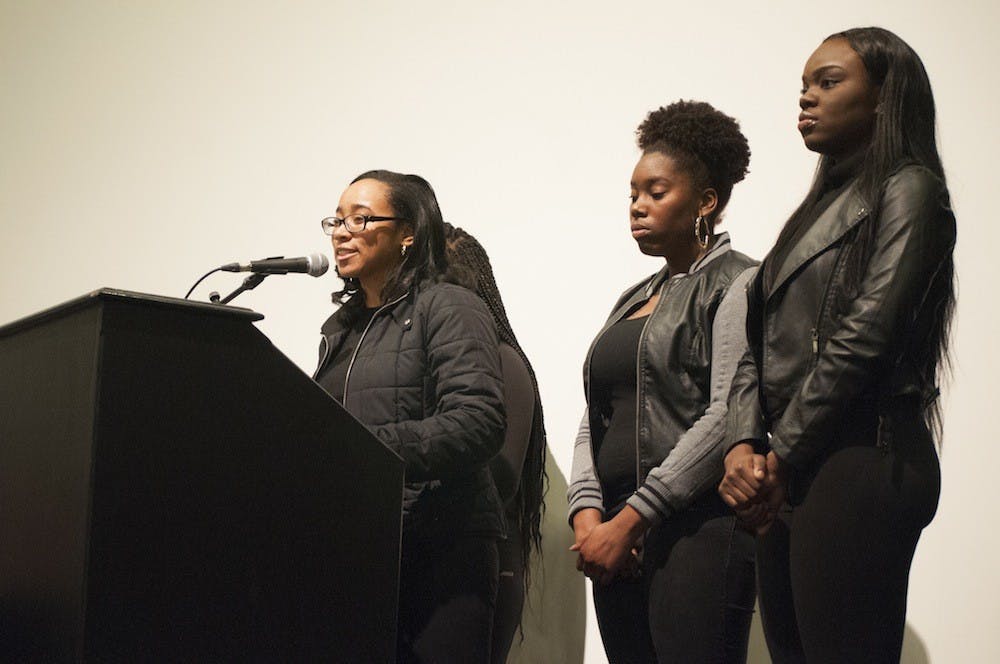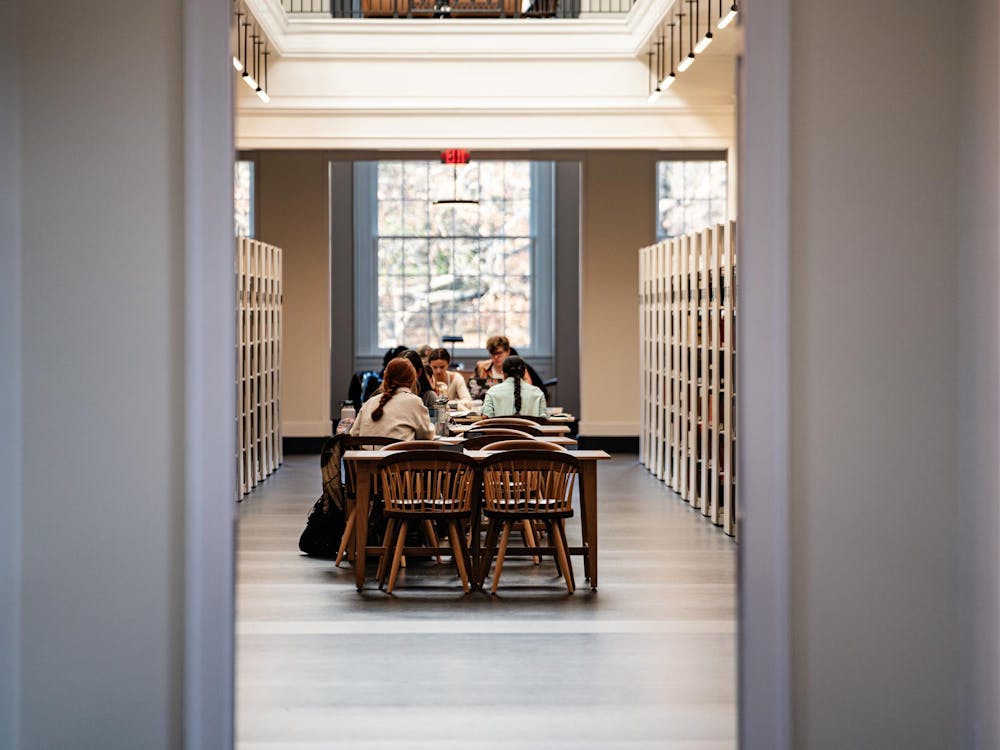Black Student Alliance President Joy Omenyi and BSA Political Action Chair Aryn Frazier sat down with The Cavalier Daily Saturday to reflect on events of the past week following the arrest of Martese Johnson in the early morning of Wednesday, Mar. 18. Omenyi and Frazier discussed what they viewed as contributing factors, student and national reactions and their plans for moving forward.
Omenyi is a fourth-year College student and Frazier is a second-year College student.
Johnson’s apprehension by Alcoholic Beverage Control agents, the details of which remain undetermined, allegedly took place after a discrepancy over the zip code on identification he presented when looking to enter Trinity Irish Pub on the Corner. Video footage of the arrest, showing Johnson on the ground with his head bleeding, has since gone viral, bringing national media to Charlottesville for the third time this academic year.
Amid the recent frenzy, Omenyi and Frazier both said it is important to remember that there were many contributing factors leading up to the altercation — “race being one of them.”
“It would be misleading of us to try to make this only a racial issue, because it’s not,” Frazier said. “This is a convergence of a lot of problems.”
A significant problem lies with ABC, Omenyi said, referring back to the case of Elizabeth Daly, a University student who was arrested in the parking lot of Harris Teeter in 2013 after ABC agents mistook a case of water for beer, leading one agent to draw a weapon.
“I think there needs to be a review of ABC and and what their powers are,” she said. “After the incident with the other young lady happened, you put things into place to make sure that doesn’t happen again.”
Omenyi said there are issues with law enforcement outside the bounds of the University that students do not necessarily hear about, and said there should also be a wider review of “what is going on in the greater Charlottesville area.”
Omenyi and Frazier said the common factor between the Johnson case and others which have received national attention — including the cases of Eric Garner and Michael Brown — is the element of police brutality, in particular the convergence of that with black bodies. Omenyi said being a part of the national conversation could prove beneficial, as national coverage is an impetus for change.
“I don’t think it can be removed from the greater conversation about everything that’s going on,” Omenyi said. “I think the fact that there is this nationwide coverage has forced the University community to pay attention to this case and to take it with all seriousness. [It is] really forcing us to evaluate ourselves as a University community. What are these issues that are causing us to be in the spotlight for the third time?”
Johnson himself has been framed as part of a larger narrative about police brutality against black Americans, his name mentioned alongside Michael Brown, Eric Garner and Trayvon Martin. His leadership status — specifically his position on the Honor Committee — has been highlighted in both local and national media. In a similar way, Trayvon Martin’s school records and character were closely examined following his death, Omenyi said.
“I think in situations like these, no matter the victim of the situation, there’s always a narrative that’s going to be painted,” Omenyi said. “It’s important because when you talk about relating this to all the other cases, in many of those cases it was, ‘This person has a criminal background, this person has done such and such.’”
Omenyi said that while the details of each case — and the narratives presented by media — vary widely, the common outcomes speak to a greater systemic problem.
“When you add in all these different elements, if the story stays the same, what does that mean?” Omenyi asked. “This could happen to any person regardless of their background.”
As news of Johnson’s arrest spread — with it pictures and video footage showing the violent nature of the arrest — hundreds of University students have attended events which have collectively generated a vociferous response. Omenyi said the mass meeting of students held in the amphitheater on Wednesday night was an important step, and allowed students to express emotions and be heard.
“It was a space for us to begin the healing process — there were so many emotions going through peoples minds,” Omenyi said. “At the end of the day I do think it was effective that people who needed to say something were able to say something, and on a grand scale.”
Omenyi said while it is hard to characterize student reactions as a whole, most experienced the same initial reaction of concern and hurt. Many students have reached out to her, she said, and expressed disgust, anger or sadness over the incident.
“This was a communal wound, a University wound,” Omenyi said.
For the BSA, the incident was a unifying one. Omenyi said the BSA constitution includes all black students at the University beginning at matriculation, though any student can join. There are no membership dues, and no requirements for involvement, so the group tends towards a decentralized structure. It was not hard, however, to get people to come together in the wake of Johnson’s arrest, Omenyi said.
“I think what happened with Martese was galvanizing,” she said. “People realize that this is the time that we need to do that community building.”
For a Student Council panel session with representatives from ABC, local police state officials held Friday afternoon, BSA prepared hard hitting questions for panel members and chanted “answer the question we asked” when they felt an answer they were given was indirect or insufficient. Omenyi said when panelists provided inadequate answer, they would be asked the same question again.
“We organized that plan because we knew the kinds of questions we had, they were trained to work around,” Omenyi said. “We would not be accepting inadequate answers.”
Moving forward, Omenyi and Frazier said the BSA has a four-part plan in working towards creating a “better U.Va.” Black Dot shared this plan with members and student, faculty and alumni allies at a meeting Sunday night. The plan focuses on creating a culture of trust, the elimination of physical and economic abuse, the proper allocation of resources and an increased presence of both black faculty and students at the University, Omenyi and Frazier said.
“One of the big things that we want to do is create a culture of truth at U.Va., and that culture of truth needs to extend to Charlottesville as well,” Frazier said. “Those are conversations around race but those are also the conversations we’re having with people in these positions of power being completely honest with where they are currently, where they’ve been and what it is they’re doing.”
Frazier said the “culture of truth” also extends to conversations within the classroom about the history of both Virginia and the University in order to teach students how to be citizens of Charlottesville before teaching students how to be citizens of the world.
The elimination of economic, psychological and physical abuse in the greater Charlottesville area, Omenyi said, is another important factor in creating a “better U.Va.”
“This university is the largest employer of Charlottesville residents but doesn’t pay them a living wage,” Omenyi said. “That’s economic abuse — these people who clean our classrooms and feed us every single day — they’re the same ones the police are protecting us from, so how does that work?”
Omenyi said students need to be citizens of Charlottesville before being a citizen of any other place.
“The biggest part of that is respecting the people who do all this work for us,” Omenyi said.
“Respecting the people’s whose home we come into for four years and leave… it’s an abusive relationship between the University and the Charlottesville community.”
Another aspect of the larger plan is the proper allocation of resources, which entails making sure both monetary and spatial resources are distributed appropriately, Frazier said.
“Part of that is actual funding … making sure that funding is going to the proper places, as opposed to going through administrative ties,” Frazier said.
Frazier said another scant resource is space. In the past week, she said, the BSA has had difficulty finding space for the hundreds of students wanting to meet.
“It’s been recognized that its something the University values that those students have that space to collaborate amongst themselves,” Frazier said. “We need space for people to be able to meet and to be able to host their cultural programming and to really be amongst themselves.”
The BSA’s plan also focuses on an overall increase of black presence on Grounds, including increasing and retaining the number of black students and faculty, Frazier said.
“For black students who attend the University and for any students who attend the University, it’s very unlikely you’ll have a black professor,” Frazier said. “What does that say to black students about the university they attend, and also about what they think they should be doing with their degree?”
Omenyi said the recruitment and retainment of minority students is an issue which affects other minority populations as well as black students.
“It's important that this conversation is not just limited to the black populations,” Omenyi said. “This is an issue for many communities of color.”





